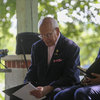Sheriff wants to buy Clarksville school, with sights on social services
The Enterprise — Melissa Hale-Spencer
“If they had access, there’s a chance we could break that cycle and save some kids,” Sheriff Craig Apple said of bringing county support services to Clarksville, close to the Helderberg Hilltowns. He addressed a crowd Wednesday at a Bethlehem school district forum.
A crowd of 80 — many of them Clarksville residents still distressed that their neighborhood school was closed six years ago — attended a forum Wednesday to learn about Albany County Sheriff Craig Apple’s plan to purchase the school to bring support services closer to the rural Hilltowns.
The sheriff’s office began leasing the building in 2012, a year after the school was closed. The county pays $54,000 annually to lease the building, which serves as a home base for 85 to 90 deputies on patrol as well as housing the county’s emergency management center. Additionally, New Scotland pays to have its town court held in the building.
Members of the Bethlehem School Board, who will ultimately make the decision on whether or not to sell the school, listened quietly. After the meeting, the board’s president, Matthew Downey, told The Enterprise, “There is no timeline. We’re in the preliminary stages and are looking for additional feedback.”
Downey said the lease was up in June. “If the sheriff says he’s vacating, we’d have to make a decision,” said Downey.
The school building and the 12.21 acres it sits on has a full market value of $1.7 million, according to the county’s assessment rolls. However, the school district hired an appraiser — Caryn Zehn Appraisals — who set the value at $410,000. According to Judith Kehoe, the district’s chief business and financial officer, the appraiser said other schools for sale have sat unsold for 12 to 36 months and sold for a fraction of the asking price.
“There’s a relatively limited buyer’s market,” she said for vacant school buildings.
Kehoe also said the school’s historic designation could case additional regulations, being a drawback for sale. First opened in 1948, the Clarksville school was put on the National Register of Historic Places in 2008, recognized as being part of the Modern Movement style, for example, using natural light.
Albany County Executive Daniel McCoy told The Enterprise this week he wouldn’t want to purchase the Clarksville School for a high price and there was no justification for putting county services in the building. (See related story.)
Apple responded through The Enterprise, after Wednesday’s forum, that he didn’t need taxpayers’ money from the county to buy the building. “I would buy the building with asset forfeiture money,” he said, referring to funds gotten from people arrested for crimes.
Asked if asset forfeiture money would total $410,000, Apple responded, “I’m not going to pay that appraisal; the building’s not worth $400,000. It needs $700,000 in asbestos abatement.”
He also said, referencing an Enterprise article, that the Hilltown supervisors are in favor of his plan. “They see the need,” said Apple.
View from BCSD
Jody Monroe, superintendent of the Bethlehem schools, opened the forum by going over enrollment projections, which are in steady decline. Total enrollment for 2017-18 is projected at 4,500 students, a decline of nearly 2 percent from this year. The enrollment for 2021-22 is 4,179, part of an ongoing downward trend, she said, noting that a decade ago, enrollment was over 5,000.
Monroe said that to reopen the building and upgrade systems in Clarksville would cost about $900,000 plus the annual cost of running the school.
“If we chose not to sell, we risk losing the sheriff’s,” said Kehoe, noting no other tenants have been identified.
She said maintenance cost for the vacated school would total $26,000 annually. Also, she said, a five-year facilities plan identified $2.1 million in needed repairs.
Bonds are still outstanding on work done in 2003, which won’t be paid off until June 2022, said Kehoe. If the school is sold, the proceeds would be restricted for payment of that debt, she said.
Bethlehem voters in 2003 had approved a $93 million bond issue to address increasing enrollment in the district by expanding the Clarksville school and building a new elementary school — Eagle. The district had considered expanding Clarksville from 12 to 18 classrooms but decided, instead, to split the growth between a slightly expanded Clarksville and a brand new school.
The committee evaluating the options concluded that new construction and some expansion would be best, then-superintendent Leslie Loomis said, because it was important to the district to keep Clarksville a small neighborhood school.
According to a 2010 long-range planning study conducted by the Bethlehem school district, the percentage of potential for residential development over the next five years, until 2015, was 83 percent in Clarksville — the highest for the district’s six elementary schools.
In March 2011, after enrollment began declining, the Bethlehem School Board, in a split vote and against the recommendation of the superintendent at the time, decided to close the Clarksville school. Members who voted in favor of the closure said it would save $900,000, helping to close that year’s $1 million budget gap. At the time, Bethlehem had six elementary schools; the other five are all in the town of Bethlehem while Clarksville served students who lived in the town of New Scotland.
The New Scotland Town Board passed a resolution in 2011, opposing the closing of the school. Thomas Dolin, the New Scotland supervisor at the time, pointed out that the town of New Scotland paid 8 percent of Bethlehem school taxes and its children made up 5 percent of the district’s enrollment, noting New Scotland residents in the Bethlehem school district more than pay for Clarksville Elementary. Building the new Eagle school, which opened in 2008, created the crisis, Dolin said.
After Clarksville Elementary closed, its students were re-assigned to either Eagle Elementary School or Slingerlands Elementary School.
“There is a lot of treasured history of the Clarksville building,” said Kehoe, stating plans would be made to preserve the peace pole and bronze plaque and that artwork applied to the walls could be digitally reproduced.
Sheriff’s vision
“We try to be good neighbors,” Apple told the crowd at Wednesday’s forum. The questions he now faces, he said, are: “Do we stay? Do we build somewhere?”
Clarksville’s central location in the county is good for patrols, he said. Apple said the gym and cafeteria are currently used by the community and he would like to upgrade the playing fields for youth sports.
“My dream would be to make the police station half of it,” said Apple and use the rest for support services. “A lot of people up on the mountain don’t like to go down to the city. ...We could help a lot of people lead a better life,” he said.
Altogether, Apple said earlier, including the cafeteria and gym, the building is about 32,000 square feet, and currently has about 5,000 square feet vacant.
Apple said on Wednesday he would like to build a single-story 40-by-40 foot garage for large pieces of equipment. The garage would be next to the school’s parking lot. “We want to bring everything back home,” he said.
He also said an area on the grounds might be set up for mediation or prayer, used by people coping with the aftermath of crime or crashes. Apple said the vernal pool referenced by some residents might be an appropriate setting.
Concerns raised
Andrea Lee of Delmar said the district made “really bad” enrollment projections before Eagle elementary school was build. She said the mistake was costly and that now young students from Clarksville have long rides on a school bus.
Monroe responded that the district worked with the Capital Region Planning Commission to come up with the current projections and noted that enrollment has declined in many of the suburban districts.
Several residents raised concerns about the lengthy bus rides. Judy Abbott said that some kindergartners ride the bus for an hour and 15 minutes each way. She noted Clarksville wasn’t represented on the school board and said the treatment of children was “unequal.”
Riobart Breen said he and his wife came to Clarksville to send their children to its community school; they have five young children. Because of the school closing and the long bus ride that would mean for his children, Breen said they had chosen to homeschool their children.
He suggested creating an ad hoc committee to look at other options for the school, such as housing an agricultural program or BOCES classes.
“People could take a look at it for the best choice instead of one choice,” said Breen.
The neighboring Guilderland school district, faced with declining enrollment and empty classrooms hired a consultant who recommended closing one of the district’s five community elementary schools. Massive citizen protests led the district instead to go through a process where community members and school leaders examined a number of uses for the vacant classrooms. Ultimately, all the schools stayed open and several of the schools now have rooms rented to a preschool program.
“Riding an hour to school in kindergarten is ridiculous,” said Karen Riley. She also said, “Clarksville was forgotten.”
Russell Riley of Clarksville, who sat next to Karen Riley, said he has worked in the construction business for 40 years, and would be cheaper to build new classrooms than to bring back the Clarksville school to useable condition.
Leslie Hatfield asked about the impact on property values with the loss of a neighborhood school. Kehoe responded there were no formal studies but it was noted Clarksville homes are still in the Bethlehem school district.
Hatfield also asked if the sirens could be turned down “a little bit when you zip through town.”
“It feels like this is a done deal,” said Seanan Herrick of Delmar. “I think the battle was lost when the school closed.” She suggested a Clarksville group be formed to make decision about what to do with items like the peace pole.
“When you decided to close Clarksville, my heart was broken,” said Tanya Choppy of Stovepipe Road. Four generations of her family had gone to school there, she said.
Taking the emotion out of it, she said that selling the school is “probably for the best, but I hate it.”
“This is far from a done deal,” concluded Apple. “At the end of the day, we may not be able to afford it.”
“If the school was to be sold, Clarksville couldn’t get a better neighbor,” said Lee.


